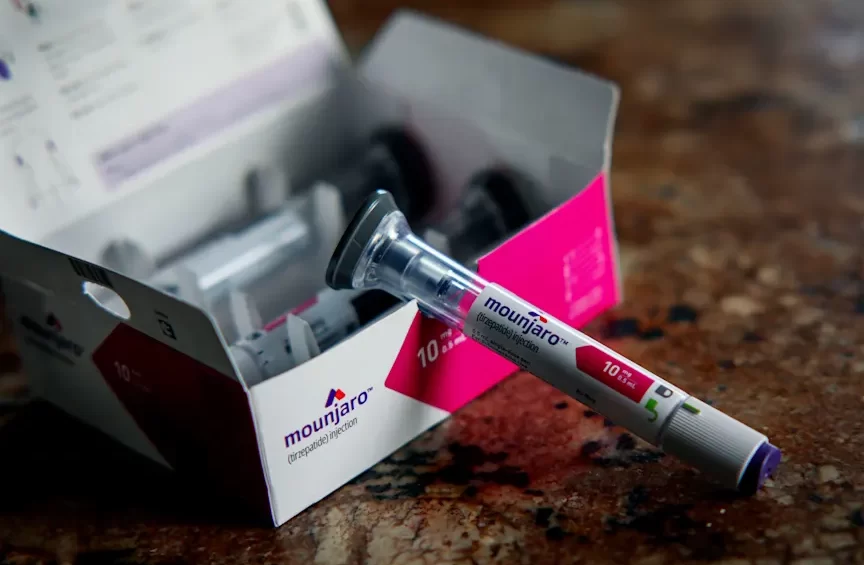In my clinic, more patients have been bringing up Mounjaro (tirzepatide). It’s a newer option for type 2 diabetes and has also been getting attention for helping with weight loss. As interest grows, it makes sense that people want to know not only how effective it is, but also whether it’s safe (Mounjaro side effects)
The questions I hear are often very specific. Someone might ask, “Can Mounjaro cause hair loss?” Another may say they’ve noticed leg cramps. Others want to know if it can affect mood, trigger migraines, or cause skin changes. Concerns like these come up a lot, and I think it’s important to talk about them openly. In this article, I’ll walk you through the real side effects patients report, what the research shows, and how I weigh the risks against the benefits in daily practice.
How Mounjaro Works
Mounjaro belongs to a newer class of medications that target two hormones (GLP-1 and GIP) to regulate blood sugar and appetite. This dual action is one reason many patients see significant improvements in both glucose control and weight loss.
However, like any medication that interacts with the body’s metabolism, Mounjaro can cause side effects. Understanding these effects helps patients make informed choices and recognize when something is normal versus when it may require medical attention.
The Most Common Side Effects
In clinical trials and in my own patients, the most frequent side effects have been gastrointestinal. These usually appear in the first few weeks and may lessen as the body adapts.
- Nausea and vomiting (especially at higher doses).
- Diarrhea or constipation.
- Bloating, abdominal pain, or reduced appetite.
- These symptoms are typically temporary. I often advise patients to eat smaller meals, avoid high-fat foods, and stay hydrated.
Mounjaro Side Effects: Hair Loss
A concern that often catches people off guard is Mounjaro side effects hair loss. In the official trial data, hair loss is not listed as a direct or expected reaction to tirzepatide. Still, some patients do report noticing thinning hair after they begin treatment, and there are a couple of likely reasons why this happens.
The first is rapid weight loss. When the body goes through a sudden drop in calories or weight, it may trigger a temporary shedding phase called telogen effluvium. In this state, the body focuses on essential systems and slows down hair growth for a time.
The second has to do with stress and nutritional changes. It’s not unusual for changes in nutrition or hormone balance to affect the hair cycle, especially during weight loss.
When I see this in a patient on Mounjaro, I usually suggest checking nutrition closely, reviewing thyroid function, and making sure protein and micronutrient intake are solid. In the majority of cases, the hair grows back as the body adjusts to the changes.
Mounjaro Leg Cramps
Another issue that patients bring up is Mounjaro leg cramps. While not a dominant side effect in trials, some individuals do report muscle cramping or discomfort.
Leg cramps may be linked to:
- Electrolyte imbalances from fluid loss due to diarrhea or reduced food intake.
- A lack of fluids during therapy can lead to dehydration.
- Changes in activity level (many patients increase exercise as they lose weight).
My clinical advice is to stay well hydrated, include potassium and magnesium in the diet, and stretch regularly.When cramps continue or become more uncomfortable, I check for other factors, such as interactions with a patient’s other medicines.
Does Mounjaro Cause Depression?
The question comes up fairly often, but at this stage, research hasn’t shown that tirzepatide itself leads to clinical depression. Still, medications that affect weight, appetite, and hormones can have an indirect impact on how people feel. While many welcome the progress, I’ve met patients who struggle with the emotional side of such rapid changes.
In addition, GLP-1 medications have been studied for possible effects on mood, but the data are still evolving. If those feelings of low mood or anxiety keep showing up during treatment, I’ll often recommend a proper mental health evaluation. While depression is not a primary side effect, monitoring mental well-being is just as important as monitoring physical health.
Mounjaro Migraines
Some people on the drug report headaches, and a smaller number talk about them as Mounjaro migraines.
These may occur due to:
- Blood sugar fluctuations occur as glucose levels stabilize.
- Changes in hydration or eating patterns (for example, skipping meals).
- Medication interactions with other prescriptions.
When someone has a history of migraines, I usually recommend tracking their headaches to see if they line up with their injections. Paying attention to hydration, nutrition, and stress levels can go a long way. Still, if the migraines become severe or start getting in the way of daily activities, that’s when I talk with them about whether we should continue with Mounjaro.
Mounjaro Skin Sensitivity
Injection-site reactions are expected with a medication given under the skin. Some patients report redness, itching, or tenderness at the site. In addition, I have heard concerns about Mounjaro skin sensitivity beyond the injection site.
This can show up as:
- Hives or rashes (rare but possible allergic reactions).
- Increased sensitivity to touch or mild irritation.
- Dry skin due to changes in hydration and metabolism.
In most cases, these side effects are mild. Rotating injection sites and using a cold pack usually helps. The only time I worry is if a patient develops widespread hives, swelling, or any trouble breathing. Those are warning signs of a possible allergic reaction and need urgent care.
Weighing the Benefits Against the Risks
Like any treatment, Mounjaro has both positives and downsides. For many people living with type 2 diabetes or obesity, the benefits are hard to ignore. Improving blood sugar levels lowers the chances of kidney disease, vision problems, nerve damage, heart issues, and stroke. The weight loss that often comes with it can also help bring down blood pressure, improve cholesterol, and make daily movement easier.
Mounjaro does not suit every patient. Some people experience major improvements, while others may run into side effects that make it less tolerable.
When to Seek Medical Attention
Patients should contact their doctor if they experience:
- Severe or persistent vomiting and diarrhea leading to dehydration.
- Unexplained hair loss that continues despite good nutrition.
- Frequent or painful Mounjaro leg cramps.
- Mood changes raising concern about does Mounjaro cause depression.
- Worsening headaches or recurrent Mounjaro migraines.
- Significant Mounjaro skin sensitivity or signs of allergic reaction.
In such cases, adjusting the dose, slowing the titration schedule, or switching medications may be necessary.
Closing Thoughts
Mounjaro has become an important option for people managing diabetes and working toward weight loss. As with any treatment, Mounjaro can bring side effects. Digestive problems are the most frequently reported, while issues such as Mounjaro side effects hair loss, Mounjaro leg cramps, does Mounjaro cause depression, Mounjaro migraines, and Mounjaro skin sensitivity are less common, but they are still important to recognize and discuss.
The most important factor is tailoring treatment to the individual. Keeping track of symptoms, staying in close touch with your healthcare provider, and making adjustments to daily habits can make a big difference in safety and success.
If you are thinking about starting Mounjaro, the choice should be guided by your overall health, your personal goals, and how well you tolerate the medicine. For most patients, consistent follow-up and medical support make it possible for the positives of Mounjaro to outweigh the side effects.






